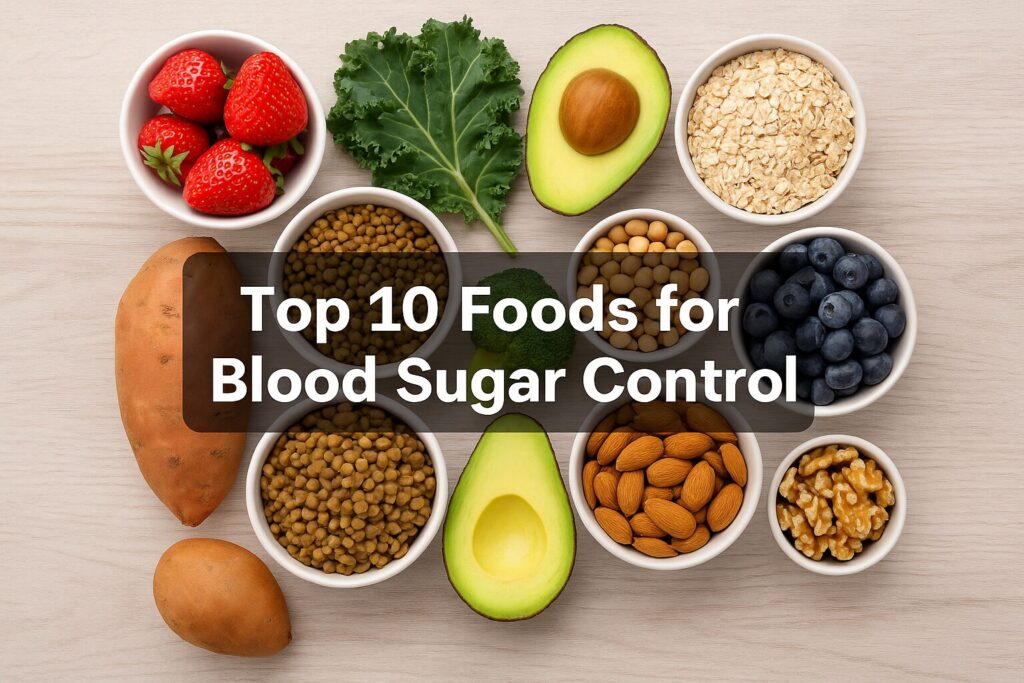The Top 10 Foods for Blood Sugar Control: Blood sugar control plays a critical role in maintaining energy levels, preventing chronic disease, and improving overall health. Millions of people today—whether managing diabetes, prediabetes, or aiming to optimize their well-being—are searching for practical ways to stabilize glucose levels naturally.
let’s know: How Sugar Affects Mood and Energy

At the heart of this conversation is one essential word: Glycemic. The term “glycemic” relates to glucose (blood sugar) in the body. More specifically, when we discuss the glycemic index (GI), we’re referring to how quickly a food increases blood sugar after consumption. Foods are ranked on a scale from 0 to 100 based on how they affect blood glucose. Lower GI values indicate slower, more stable glucose release—while higher GI values mean rapid spikes in sugar, followed by energy crashes.
But there’s another important concept: Glycemic Load (GL). Unlike GI, which focuses on the quality of carbohydrates, GL takes both quality and quantity into account. This makes it a more accurate way to predict how a real-life portion of food will impact your blood sugar.
So, why does all this matter?
Eating foods that are high on the glycemic scale—like refined grains, sugary drinks, or overly processed snacks—can lead to inflammation, insulin resistance, weight gain, and increased risk of type 2 diabetes. On the other hand, choosing low-glycemic foods helps promote stable energy levels, fewer cravings, and long-term metabolic health.
In this comprehensive guide, we’ll highlight the top 10 foods for blood sugar control, breaking down how each one works in your body, how it ranks glycemically, and practical ways to enjoy it. These are whole, nutrient-dense options that support insulin function, slow digestion, and keep you feeling satisfied.
If you’ve been searching for a reliable way to stabilize your blood sugar naturally, look no further. The foods we’re about to explore are not only scientifically backed but also delicious and easy to incorporate into your daily life.
The Science Behind the Top 10 Foods for Blood Sugar Control
Understanding the glycemic impact of what you eat is the first step toward better blood sugar balance. The top 10 foods for blood sugar control share common features:
- Low glycemic index or load
- Rich in fiber, protein, or healthy fats
- Packed with vitamins, minerals, and antioxidants
- Slow to digest, leading to gradual glucose release
Let’s break down these powerhouse foods one by one.
1. Lentils – A Fiber-Rich Staple for Stable Glycemia
Why Lentils Are Among the Top 10 Foods for Blood Sugar Control
Lentils are rich in complex carbs, plant-based protein, and soluble fiber, making them a perfect blood sugar–friendly food. Their GI ranges from 32–38, meaning they digest slowly and release sugar steadily into your bloodstream.
This slow-release effect helps you stay full longer, reduces cravings, and minimizes blood sugar spikes after meals.
Glycemic benefits:
- High in magnesium: improves insulin sensitivity
- Low GI: minimizes blood sugar fluctuations
How to use: Add to soups, curries, or use as a base for veggie bowls.
2. Sweet Potatoes – A Natural Source of Low-Glycemic Carbs
Sweet Potatoes as One of the Top 10 Foods for Blood Sugar Control
Sweet potatoes—especially when boiled—have a significantly lower GI (44–63) than regular white potatoes. The rich fiber content slows digestion, and antioxidants like beta-carotene add extra health benefits.
They’re also rich in potassium and vitamin C, supporting heart and immune health.
Pro tip: Chill cooked sweet potatoes before eating to increase resistant starch and lower glycemic impact.
Enjoy in: Roasted wedges, mashed with herbs, or added to power bowls.
3. Steel-Cut Oats – Whole Grains That Support Glycemic Balance
Why Oats Belong in the Top 10 Foods for Blood Sugar Control
Steel-cut and old-fashioned oats have a GI between 42–55, depending on how they’re prepared. They contain beta-glucan, a soluble fiber that helps reduce post-meal blood glucose levels.
Oats also support cholesterol control and digestive health, making them a multi-benefit superfood.
Avoid: Sugary instant oatmeal packets that raise the glycemic index.
Eat with: Berries, cinnamon, or nut butter for flavor and added nutrients.
4. Chickpeas – The Protein-Packed Glycemic Buffer
How Chickpeas Secure a Spot in the Top 10 Foods for Blood Sugar Control
Chickpeas (also known as garbanzo beans) have a low GI (28–36) and are full of fiber and protein. These nutrients help delay carbohydrate absorption, reducing blood sugar spikes and keeping you fuller for longer.
Chickpeas also support gut health through their resistant starch content.
Perfect in: Hummus, salads, stews, or roasted for a crunchy snack.
5. Leafy Greens – Virtually Glycemic-Free Superfoods
Why Leafy Greens Rank High Among the Top 10 Foods for Blood Sugar Control
Leafy greens like spinach, kale, collards, and Swiss chard are extremely low in carbs, making their glycemic effect negligible. They are rich in antioxidants, magnesium, and fiber—all of which contribute to better insulin sensitivity.
Eating greens with higher-carb meals can slow glucose absorption and blunt sugar spikes.
Use in: Smoothies, omelets, soups, or salads.
6. Berries – Low-Glycemic Sweetness with Antioxidant Power
Why Berries Make the List of Top 10 Foods for Blood Sugar Control
Berries like raspberries, strawberries, and blueberries have a GI between 25 and 40, making them ideal for sweetening meals without spiking blood sugar.
Loaded with polyphenols, they can help improve insulin sensitivity and lower inflammation, both key to long-term glycemic stability.
Pair with: Greek yogurt, oats, or sprinkle on salads.
7. Nuts – Healthy Fats for Glycemic Management
How Nuts Fit into the Top 10 Foods for Blood Sugar Control
Almonds, walnuts, pistachios, and cashews have very low GIs and help slow digestion, thanks to their healthy fat, fiber, and protein content. They blunt the blood sugar impact of carbohydrate-rich meals.
Study-proven effects:
- Reduced HbA1c
- Lowered fasting glucose
- Improved insulin function
Eat as: Snacks, nut butters, toppings for yogurt or oatmeal.
8. Greek Yogurt – The Low-Glycemic Dairy Winner
Why Greek Yogurt Deserves a Place Among the Top 10 Foods for Blood Sugar Control
With a GI of 20–30, unsweetened Greek yogurt is low in carbs but high in protein and probiotics. It aids digestion, supports gut flora, and helps control blood glucose.
Avoid flavored versions with added sugar.
Great with: Chia seeds, cinnamon, or fresh berries.
9. Quinoa – The Balanced Carb with Protein Punch
What Makes Quinoa One of the Top 10 Foods for Blood Sugar Control
Quinoa has a moderate GI (~53), but its glycemic load is low due to its rich fiber and protein profile. It also contains beneficial amino acids, which contribute to slower digestion and stable glucose levels.
Use as: A rice substitute, salad base, or stir-fry filler.
10. Avocados – No-Glycemic Impact, All-Nutrient Superfood
Why Avocados Complete the Top 10 Foods for Blood Sugar Control
Avocados are virtually carb-free, with no glycemic effect, and are rich in monounsaturated fats, fiber, and potassium.
Adding avocado to meals can lower the overall glycemic load and improve heart and metabolic health.
Perfect in: Toasts, salads, smoothies, or guacamole.
The Role of Glycemic Index vs. Glycemic Load in the Top 10 Foods for Blood Sugar Control
When evaluating the top 10 foods for blood sugar control, it’s important to understand the difference between glycemic index and glycemic load:
- Glycemic Index (GI): Measures how fast carbs in food raise blood sugar.
- Glycemic Load (GL): Considers both the quality and quantity of carbs in a serving.
Even high-GI foods like watermelon can have a low glycemic load due to their water content. Meanwhile, even a lower-GI food can be problematic in large quantities.
Additional Tips Beyond the Top 10 Foods for Blood Sugar Control
To enhance the benefits of a glycemic-friendly diet, try these lifestyle tips:
- Exercise daily to improve insulin sensitivity
- Stay hydrated to help kidneys flush out excess sugar
- Limit highly processed carbs and sugars
- Combine carbs with protein or fat to lower glycemic impact
- Manage stress to reduce cortisol and blood sugar spikes
Conclusion: Start with the Top 10 Foods for Blood Sugar Control Today
Glycemic awareness isn’t about deprivation—it’s about choosing foods that nourish your body while keeping your blood sugar stable. The top 10 foods for blood sugar control—from lentils and oats to avocados and berries—offer the perfect combination of taste, nutrition, and metabolic support.
By integrating these foods into your meals, you’re not just managing glucose—you’re supporting your heart, brain, gut, and overall vitality.
Consistency is key. Start small, swap smarter, and keep the glycemic load low. With the top 10 foods for blood sugar control, you can eat well and feel better every day.




